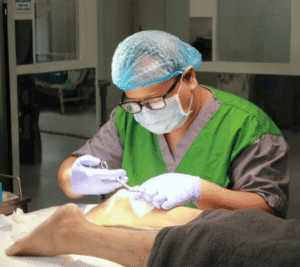Pressure sores, also known as bedsores or pressure ulcers, pose a significant health risk to individuals with limited mobility. These wounds develop from prolonged pressure on the skin, often over bony areas such as the hips, heels, and tailbone. Without proper attention, pressure sores can cause severe pain, infections, and even lead to life-threatening complications. Understanding pressure sores treatment options is crucial for patients, caregivers, and healthcare providers alike to restore comfort, dignity, and mobility.
What Are Pressure Sores?
Pressure sores are injuries to the skin and the underlying tissue caused by constant pressure, friction, or shear. When pressure is applied for an extended period, it restricts blood flow to the affected area, leading to tissue damage and necrosis. Commonly affected areas include the hips, heels, tailbone, elbows, and shoulders—places where the bones are close to the skin.
People who are bedridden, use wheelchairs, or are unable to change positions frequently are particularly vulnerable. Pressure sores can range from mild skin redness to deep ulcers exposing muscle or bone. If left untreated, these wounds may become infected, leading to complications such as cellulitis, osteomyelitis, or sepsis.
Who Is at Risk of Developing Pressure Sores?
Understanding who is at risk helps in preventing and managing pressure sores effectively. Patients with limited mobility, including those confined to beds or wheelchairs, are the most susceptible. Elderly individuals often face higher risk due to thinner skin and reduced circulation. Additionally, patients with chronic illnesses such as diabetes, vascular diseases, or neurological conditions may have impaired healing abilities, increasing their vulnerability.
Early identification of pressure sores is critical to prevent worsening. Caregivers and family members should be educated about risk factors and warning signs to facilitate timely pressure sores treatment.
Symptoms and Stages of Pressure Sores
Recognizing the symptoms and stages of pressure sores can help prompt early treatment and prevent further tissue damage.
- Stage 1: The skin appears red or discolored but remains intact. The area may feel warm or firm.
- Stage 2: Partial-thickness skin loss occurs, resembling a blister or shallow open sore.
- Stage 3: Full-thickness skin loss exposes underlying fat but does not reach muscle or bone.
- Stage 4: Deep tissue damage exposes muscle, bone, or tendons, often accompanied by severe infection.
Patients or caregivers noticing any of these signs should seek professional pressure sores treatment immediately to avoid complications.
Effective Pressure Sores Treatment Options
A successful pressure sores treatment plan combines medical interventions, lifestyle adjustments, and preventive measures. Here are the key components:
Wound Cleaning and Dressing: Proper wound care is fundamental. The ulcer must be cleaned regularly using saline or other recommended solutions to prevent infection. Dressings that maintain moisture balance—such as hydrocolloids, foam, or alginate dressings—promote faster healing and protect the wound from contaminants.
Pressure Relief: Alleviating pressure from affected areas is critical to allow tissue recovery. Specialized pressure-relieving cushions, mattresses, and overlays help distribute weight evenly, reducing stress on vulnerable spots. Repositioning the patient every two hours also prevents prolonged pressure on any single area.
Nutrition and Hydration: Optimal nutrition supports skin health and wound healing. A diet rich in protein, vitamins (especially Vitamin C and zinc), and adequate fluids accelerates tissue repair. Nutritionists or healthcare providers can tailor plans to meet the patient’s specific needs.
Physical Therapy and Mobility: Improving mobility, even minimally, encourages blood circulation and muscle strength, which are essential for healing pressure sores. Physical therapists work with patients to develop movement exercises suitable to their condition, reducing the risk of new sores developing.
Holistic Approach to Pressure Sore Care
Effective pressure sores treatment goes beyond physical healing. Emotional and psychological support for patients is equally important. Bedsores can cause distress, frustration, and a sense of helplessness, especially for those with long-term immobility.
Maintaining dignity and comfort through compassionate care creates a positive healing environment. Involving family members and caregivers in treatment plans fosters a supportive atmosphere where patients feel valued and motivated.
Why Choose Kalingap Wound Care Clinic for Pressure Sores Treatment?
Located in Quezon City, Kalingap Wound Care Clinic specializes in pressure sores treatment tailored to the needs of Filipino patients. As a Filipino-led clinic deeply rooted in community values, Kalingap prioritizes compassionate care that is both affordable and accessible.
The clinic’s holistic approach ensures that patients receive more than just medical treatment—they gain a comprehensive healing experience aimed at restoring comfort, dignity, and mobility. Kalingap’s team of experienced wound care specialists uses the latest techniques and evidence-based practices to manage and treat pressure ulcers effectively.
Patients from Metro Manila and neighboring areas trust Kalingap for its personalized services, respectful treatment, and community-oriented mission.
Preventing Pressure Sores: Tips for Caregivers and Patients
Prevention remains the best strategy in pressure sores treatment. Both caregivers and patients can take simple yet effective steps to minimize risks:
- Regular Repositioning: Change the patient’s position at least every two hours to reduce pressure.
- Skin Inspection: Daily check for early signs of redness, swelling, or skin breakdown.
- Maintain Hygiene: Keep skin clean and dry to prevent irritation and infection.
- Use Pressure-Relieving Devices: Utilize specialized cushions and mattresses to distribute pressure evenly.
- Encourage Mobility: Promote movement and exercises within the patient’s capability.
- Ensure Proper Nutrition: Maintain a balanced diet rich in healing nutrients.
When to Consult a Specialist
Not all pressure sores can be managed at home. Persistent wounds, signs of infection (such as pus, foul odor, increased pain), or worsening ulcers require professional attention. Early intervention by wound care specialists improves outcomes and reduces the risk of complications.
Professional clinics like Kalingap provide advanced wound assessment, customized treatment plans, and continuous monitoring to facilitate healing and prevent recurrence.
Takeaway
Pressure sores treatment demands timely, comprehensive care that addresses both the physical wounds and emotional wellbeing of patients. Understanding the causes, risks, and symptoms empowers caregivers and patients to take proactive steps toward prevention and healing.
If you or a loved one is struggling with pressure ulcers, seeking professional care from specialized clinics such as Kalingap Wound Care Clinic can make a significant difference. Compassionate, affordable, and expert wound care services restore comfort, dignity, and mobility—helping patients regain their quality of life.






